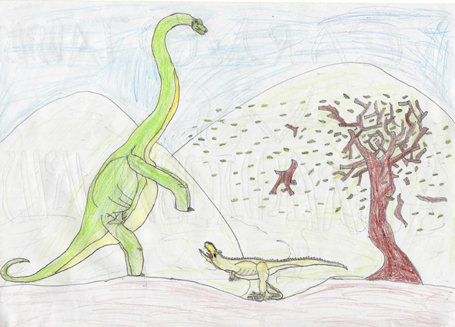The CollectA Rearing Diplodocus – Niche Partitioning
A beautifully sculpted and skilfully painted CollectA rearing Diplodocus dinosaur model helps us to demonstrate a concept called niche partitioning. The term niche partitioning is used by ecologists to explain how organisms use the resources in an environment differently to avoid competition and therefore, by doing this, they can all co-exist. Diplodocus is known to have co-existed with several other long-necked dinosaurs in the Late Jurassic, but they were able to share the same environment as they very probably fed on different types of vegetation. They were probably not directly competing with each other for resources.
The CollectA rearing Diplodocus can be posed in a rearing position, as if it is reaching high into the upper canopy of a forest in order to reach the leaves and branches at the very top of the trees that other dinosaurs could not reach. We created a short video (45 seconds), that demonstrates how the CollectA Diplodocus can be balanced to demonstrate niche partitioning.
The CollectA Diplodocus Demonstrates Niche Partitioning in the Sauropoda
Video credit: Everything Dinosaur
Providing a Challenge to Schoolchildren During a Dinosaur Workshop
When Everything Dinosaur team members visit schools, we explain this concept using dinosaurs as an example and then challenge the class to think of examples of niche partitioning within modern ecosystems. This helps reinforce understanding about food chains/food webs and how ecosystems are constructed. It also helps to demonstrate an important principle in palaeontology, the idea that we use comparisons from living creatures and environments today to help us understand life in the ancient past.
Visit the Everything Dinosaur website: Everything Dinosaur.
A Sauropod Dinosaur Rears Up

Picture credit: M. V. Eashwar
Niche Partitioning
Many types of extant herbivorous animal, normally quadrupedal, are able to rear up onto their hind legs in order to reach food that otherwise they would not be able to access. As an extension to this exercise in schools, we ask the pupils to construct food webs to reflect how the chosen ecosystem functions.
Our team members have posted up numerous articles exploring this topic area on this blog.
To read an article about niche partitioning within Jurassic marine environments: Marine Reptile Teeth Tell the Tale of Changing Seas.
An examination of why the Cretaceous of northern Africa seems to have had large numbers of super-sized predators: Why so Many Large Predators in Cretaceous Africa?
The CollectA Rearing Diplodocus Dinosaur Model
CollectA have included several sauropod figures within their “Prehistoric Life” model range. The CollectA rearing Diplodocus model is one of the larger figures within this not-to-scale range, with a rearing height of approximately 23 centimetres.
A CollectA Diplodocus Dinosaur Model
To view the CollectA rearing Diplodocus and the other CollectA models available from Everything Dinosaur: The CollectA Dinosaur and Prehistoric Animal Model Range.







Leave A Comment